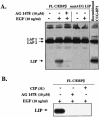Epidermal growth factor receptor stimulation activates the RNA binding protein CUG-BP1 and increases expression of C/EBPbeta-LIP in mammary epithelial cells
- PMID: 15082764
- PMCID: PMC387752
- DOI: 10.1128/MCB.24.9.3682-3691.2004
Epidermal growth factor receptor stimulation activates the RNA binding protein CUG-BP1 and increases expression of C/EBPbeta-LIP in mammary epithelial cells
Abstract
The transcription factor CCAAT/enhancer binding protein beta (C/EBP beta) is a key regulator of growth and differentiation in many tissues. C/EBP beta is expressed as several distinct protein isoforms (LAP1, LAP2, and LIP) whose expression is regulated by alternative translational initiation at downstream AUG start sites. The dominant-negative LIP isoform is predominantly expressed during proliferative cellular responses and is associated with aggressive tumors. In this study, we investigated a mechanism by which the LIP isoform is translationally regulated in mammary epithelial cells. We have demonstrated that LIP expression is increased in response to activation of the epidermal growth factor receptor (EGFR) signaling pathway and that the increased expression of LIP is regulated in part by an RNA binding protein referred to as CUG repeat binding protein (CUG-BP1). Our data demonstrate that EGFR signaling results in the phosphorylation of CUG-BP1 and this leads to an increase in the binding of CUG-BP1 to C/EBP beta mRNA and elevated expression of the LIP isoform. Phosphorylation is necessary for the binding activity of CUG-BP1 and the consequent increase in LIP expression, as determined by binding assays and a cell free, transcription-coupled translation system. CUG-BP1 is thus a previously unidentified downstream target of EGFR signaling and represents a new translational regulator of LIP expression in human mammary epithelial cells.
Figures









Similar articles
-
Expression and function of CCAAT/enhancer binding proteinbeta (C/EBPbeta) LAP and LIP isoforms in mouse mammary gland, tumors and cultured mammary epithelial cells.J Cell Biochem. 2001;82(3):357-70. doi: 10.1002/jcb.1167. J Cell Biochem. 2001. PMID: 11500913
-
LIP expression is regulated by IGF-1R signaling and participates in suppression of anoikis.Mol Cancer. 2011 Aug 19;10:100. doi: 10.1186/1476-4598-10-100. Mol Cancer. 2011. PMID: 21854628 Free PMC article.
-
CUG repeat binding protein (CUGBP1) interacts with the 5' region of C/EBPbeta mRNA and regulates translation of C/EBPbeta isoforms.Nucleic Acids Res. 1999 Nov 15;27(22):4517-25. doi: 10.1093/nar/27.22.4517. Nucleic Acids Res. 1999. PMID: 10536163 Free PMC article.
-
CCAAT/enhancer-binding protein beta: its role in breast cancer and associations with receptor tyrosine kinases.Expert Rev Mol Med. 2009 Apr 8;11:e12. doi: 10.1017/S1462399409001033. Expert Rev Mol Med. 2009. PMID: 19351437 Free PMC article. Review.
-
C/EBPß Isoform Specific Gene Regulation: It's a Lot more Complicated than you Think!J Mammary Gland Biol Neoplasia. 2020 Mar;25(1):1-12. doi: 10.1007/s10911-020-09444-5. Epub 2020 Feb 20. J Mammary Gland Biol Neoplasia. 2020. PMID: 32078094 Free PMC article. Review.
Cited by
-
The role of CUGBP1 in age-dependent changes of liver functions.Ageing Res Rev. 2012 Sep;11(4):442-9. doi: 10.1016/j.arr.2012.02.007. Epub 2012 Mar 14. Ageing Res Rev. 2012. PMID: 22446383 Free PMC article. Review.
-
A CCAAT/enhancer binding protein beta isoform, liver-enriched inhibitory protein, regulates commitment of osteoblasts and adipocytes.Mol Cell Biol. 2005 Mar;25(5):1971-9. doi: 10.1128/MCB.25.5.1971-1979.2005. Mol Cell Biol. 2005. PMID: 15713650 Free PMC article.
-
All-trans retinoic acid down-regulates human albumin gene expression through the induction of C/EBPbeta-LIP.Biochem J. 2006 Jul 15;397(2):345-53. doi: 10.1042/BJ20051863. Biochem J. 2006. PMID: 16608438 Free PMC article.
-
Hypoxia-induced proliferation of human pulmonary microvascular endothelial cells depends on epidermal growth factor receptor tyrosine kinase activation.Am J Physiol Lung Cell Mol Physiol. 2010 Apr;298(4):L600-6. doi: 10.1152/ajplung.00122.2009. Epub 2010 Feb 5. Am J Physiol Lung Cell Mol Physiol. 2010. PMID: 20139181 Free PMC article.
-
Position-dependent and neuron-specific splicing regulation by the CELF family RNA-binding protein UNC-75 in Caenorhabditis elegans.Nucleic Acids Res. 2013 Apr;41(7):4015-25. doi: 10.1093/nar/gkt097. Epub 2013 Feb 14. Nucleic Acids Res. 2013. PMID: 23416545 Free PMC article.
References
-
- Alaoui-Jamali, M. A., D. J. Song, N. Benlimame, L. Yen, X. Deng, M. Hernandez-Perez, and T. Wang. 2003. Regulation of multiple tumor microenvironment markers by overexpression of single or paired combinations of ErbB receptors. Cancer Res. 63:3764-3774. - PubMed
-
- Badley, J. E., G. A. Bishop, T. St John, and J. A. Frelinger. 1988. A simple, rapid method for the purification of poly A+ RNA. BioTechniques 6:114-116. - PubMed
-
- Baer, M., and P. F. Johnson. 2000. Generation of truncated C/EBPβ isoforms by in vitro proteolysis. J. Biol. Chem. 275:26582-26590. - PubMed
-
- Bundy, L. M., and L. Sealy. 2003. CCAAT/enhancer binding protein beta (C/EBPβ)-2 transforms normal mammary epithelial cells and induces epithelial to mesenchymal transition in culture. Oncogene 22:869-883. - PubMed
Publication types
MeSH terms
Substances
Grants and funding
LinkOut - more resources
Full Text Sources
Molecular Biology Databases
Research Materials
Miscellaneous
